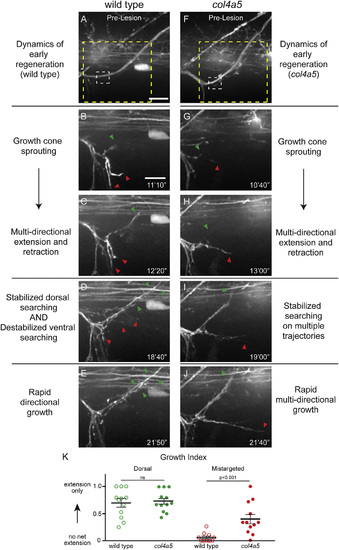Fig. 5
|
col4a5 Destabilizes Aberrant Growth Early in Regeneration (A) Wild-type dorsal nerve prior to nerve transection (white dashed box, transection site; yellow dashed box, region magnified in B–F; scale bar, 10 µm). (B and C) Wild-type axons sprout growth cones (B) and probe all regions of the injury gap (C). (D and E) Over time, axons destabilize searching on non-dorsal paths and stabilize searching on the dorsal path (D), leading to rapid directional growth (E; n = 8 larvae, 15/16 nerves). (F) col4a5 dorsal nerves develop indistinguishably from wild-type siblings (white dashed box, transection site; yellow dashed box, region magnified in H–L). (G and H) Regenerating col4a5 axons sprout growth cones (G) and search all regions of the injury gap (H). (I) Over time, axons stabilize searching on the dorsal path but fail to destabilize searching on non-dorsal paths. (J) This leads to invasion of non-dorsal regions of the myotome (n = 8 larvae, 17/25 nerves; p < 0.0001). Red arrowheads, ventral searching; green arrowhead, dorsal searching; scale bar, 10 µm. (K) The net proportion of extension and retraction movements was similar between wild-type and col4a5 fascicles on the dorsal path. In contrast, while wild-type fascicles extended and retracted with equal frequency, mistargeted col4a5 fascicles extended more frequently and stabilized to grow on aberrant trajectories. All error bars indicate ±SEM. |

